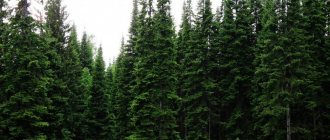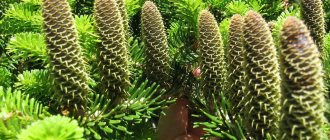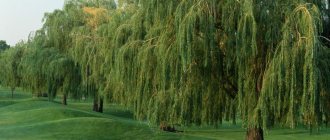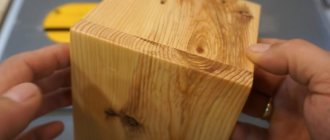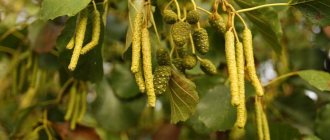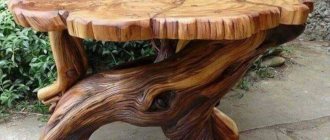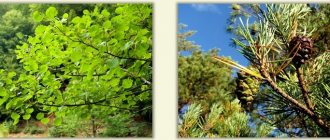Acer, or maple, is a genus of more than 150 species of trees and shrubs, widespread in the Northern Hemisphere, including throughout the European part and in temperate latitudes of Asia. There are dozens of species of maple trees in Russia. Most of them are unpretentious, shade-tolerant, frost-resistant, love well-moistened fertile soils, but some also grow on poor soils. Most of these are deciduous shrubs and trees; there are several evergreen species in Central Asia.
Description of the genus
The genus maple (Latin Acer - “sharp, strong”) is part of the Sapindaceae family (Latin Sapindaceae) and unites about 150 species, among which there are deciduous trees and shrubs. Most representatives are characterized by a high growth rate - up to 60 cm in height and up to 40 cm in width per year, but only at the beginning of life. A seven-year-old tree is already higher than 2 m. Up to 30 years of age, growth in height does not stop, and then it slows down significantly; instead, lateral branches grow vigorously. From the age of 50 upward growth is almost imperceptible. In total, trees live for at least 150 years, and according to some sources - up to 500, and the height can reach 40 m.
The main decoration of the crown is maple leaves. They have different shapes - simple, complex-fingered, complex-pinnate, but more often - palm-shaped, that is, similar to a palm with five “fingers”. The type of leaf is determined by the type of maple. The color ranges from rich green, to purple, bright red and even dark pink. The dense crown looks beautiful and perfectly clears the air of dust, which is why maples are so often planted in parks.
Young trees have smooth bark, usually gray-brown in color. With age, it can darken to black, while becoming covered with narrow and long, chaotically intertwined cracks. The bark of a young shoot is reddish-gray. The root system is superficial, lying at a depth of 20 cm widely in all directions from the trunk.
The flowering period occurs in spring from March to April. Some species bloom before the leaves bloom, others at the same time. The seeds, ripening in September-October, have wings up to 7 cm long, which help them glide in the air and easily move far from the parent plant.
Types of maple
Not all varieties are equally common; some are listed in the Red Book and are protected by the state.
Plantain maple is the most common one in Russia. Its additional names are holly, platanophyte. Can grow up to 28 m in height. It is its bark that darkens almost to black as it ages. The palmate leaf may have 5-7 serrations and is colored green, becoming yellow or reddish-orange in the fall. Interestingly, the annual growth is up to a meter, and the first fruiting occurs only at the age of 17 years.
Ash maple is also called American, Californian, and weedy. Height - up to 21 m. Opposite compound leaves have an odd-pinnate shape and a light green (to silver-white) color, turning yellow in autumn. It is considered a strong allergen, since during flowering it releases a large amount of pollen into the air, causing hay fever. Krone is not as attractive as other species, and the wood is not a valuable species.
In Russian, sycamore is not only white maple, but also other holly-leaved species. In reference books it is called false sycamore or pseudo-sycamore, in Scotland it is called sycamore, and in English-speaking countries it is called sycamore. A deciduous, broad-leaved tree with a dome-shaped crown grows up to 35 m tall. Its leaves, up to 25 cm long, have a palmate-lobed shape and various shades, depending on the variety: green, purple, yellow, crimson, yellow. Prized for its beautiful, very light (almost white) wood.
Colchis maple (Cappadocia) is a southern species, distributed throughout the Mediterranean Sea to the Himalayas and western China. Its seven-lobed, very thin leaves reach 14 cm in length, dark green on the front side, much lighter on the back. Like most other species, when the petioles are broken, they secrete a milky juice. The height of the tree is on average 12-20 m.
Properties and uses of maple
Among hardwoods, maple wood is one of the most valuable. The wood is white or pale yellow in color, and according to physical and mathematical parameters it is close to oak wood. Wood density is 0.57-0.67 g/cm3. There are a number of features that make it stand out from other trees. The late wood of the annual layers is darker in color than the early wood. Heart-shaped rays give exclusivity and recognition to maple products. Maple wood has a good ability to bend (almost like beech wood), but when steamed it changes color to yellowish-brown. During the drying process, wood can crack and warp, so you need to carefully select the drying mode. Maple is used to make furniture. Well-dried wood exhibits stability of shape and size indoors. Hardness and wear resistance are the main qualities of maple parquet. Small-leaved maple wood is preferred to be used for higher grades of plywood and for interior decoration; Mouth guards are very valuable. In the past, maple was used to make shoe nails, rims, and ax handles. No one makes spinning wheels in the modern world anymore, but you can’t find better wood than maple for fine jewelry carvings. Sculptors carve miniature figures from it. Artists engrave maple boards, cover them with paint and make prints on paper. It turns out - woodcut, i.e. “wood writing” (in Greek xylon - tree, wood).
Maple is one of the few trees that have white milky sap. The secretion of this juice can be observed after the leaves bloom - late spring or early summer. The spring sap of some maples (especially sugar and sugar maples from North America) contains significant amounts of sucrose (in other species, fructose predominates) and serves as a raw material for the production of maple sugar (particularly in Canada). The sugar maple leaf is the national symbol of Canada. Maples are decorative. All types of maples are good honey plants.
By the way, the Japanese believe that the beauty of autumn maple leaves is similar to the beauty of flowers. In Japan, special guidebooks are even created that indicate places from which a beautiful panorama opens onto groves and mountain slopes covered with these trees. As if trying to prolong the charm of autumn, the Japanese have developed varieties of maples that retain the red color of their foliage all year round.
all tree species
Spreading
On the planet, maple does not grow only in South America and Australia. On other continents it grows from the polar regions of Europe to the tropics of Central America and South Asia. In our country, 20 species are known, of which one, the Japanese one, is listed in the Red Book. The following are common in the European part of Russia:
- Tatar;
- white;
- field;
- holly.
The diversity of species found in the Far East is wider - more than 10, and 4 endemics are found only in Crimea.
Planting and care
Undemanding to soil, drought-resistant and frost-resistant plant is a frequent visitor to parks, landscape gardens, as well as forested areas almost everywhere in our country. To obtain a lush decorative crown, you will need a spacious, well-lit area. It’s not even worth planting shrubs under it, since the shadow will only become wider and denser every year.
Nurseries offer 2-3 year old seedlings with foliage of various colors. You can choose a variety with a spreading or compact (columnar) crown, low-growing or large-sized. Maple leaves can be the same color throughout the growing season, or change from green to yellow or red with the arrival of autumn.
The roots can grow well in any soil, but prefer fertile soil rich in humus. Seedlings with an open root system are planted in spring or autumn, and with a closed root system in the summer. If we are talking about transplanting an adult tree, then it is usually moved by transshipment along with a lump of earth in winter.
The planting hole has a depth of at least 70 cm (according to the size of the root system). The seedling must be tied to a support. The branches are shortened a little. Watering - as needed, in summer - weekly. But after 1-2 years, the tree independently extracts water from great depths with its roots. To obtain a beautiful crown, you will need annual pruning and fertilizing with complex mineral fertilizer.
Foliage of maple trees
It happens:
- simple;
- large;
- lobed;
- palmate.
It is the intricate shape of the leaves that forms a beautiful carved crown of a rounded shape. There are species with compound-fingered and trifoliate foliage - for example, the Manchurian tree or the species discovered by Maksimovich.
Gardeners plant specimens in plots whose foliage turns purple or bright golden by autumn. There is a variety called Crimson King. This maple even in winter has a purple crown with a violet tint. The Crimson Sentry variety has a pyramidal crown shape; by autumn its leaves darken and also become purple-red. The Deborah species is famous for its red foliage in summer, which turns bright yellow with an orange tint in autumn.
There are many variegated (variegated) species. The foliage of the Drummond variety remains dark green until late autumn.
Diseases and pests
Among insects, the following pests pose the greatest threat to maple trees:
- Caterpillars of various butterflies (moths, silkworms), eating young foliage and green fruits.
- Aphids - suck the sap from the green parts of the tree.
- The Asian longhorned beetle is a beetle that causes mass destruction of maple plantings in the USA and Canada.
- Woodworms.
- Scale insects.
- Gall mite.
- Rose leafhopper.
Various diseases do not bypass the plant:
- Fungi: Verticillium, Cryptostroma, Phytophthora, Rhytisma, Uncinula.
- Powdery mildew.
- Verticillium.
- Cancer.
- Coral spotting.
- Witch's broom.
- Tar spotting.
- Cercospora blight.
- Anthracnose.
Control methods in each case are selected according to symptoms, using broad-spectrum fungicides and insecticides, and in the absence of an effective technique, the affected plantings are destroyed.
Why is the false sycamore maple called sycamore?
According to the legends of the ancient Slavs, a person was turned or “sworn” into this tree. Therefore, maple is never used to heat a stove, nor is it used to make coffins, considering it a great sin to place living people in the ground.
A man turned into a sycamore because of a mother’s curse on her disobedient children. When the musicians pass by a maple tree, they cut it down and make a violin. Its sounds, in the voices of children, tell how their mother committed a crime in front of them.
The Serbs have a different belief. A dry maple tree will turn green if it is hugged by a person who has been wronged unfairly. And, conversely, a green maple will dry out if a deeply unhappy or offended person touches it.
Meaning and Application
The kernel-free wood of most species is yellowish in color with a pink, red or brown tint, but can be very light, almost white. The texture is beautiful, radially cut with narrow dark core rays. Easily amenable to polishing and various types of processing, it splits well.
Compared to coniferous species, it is valued higher because it is heavier, has smaller pores, high elasticity, viscosity and resilience. The board is slightly susceptible to warping, but can crack during drying and change color. The average density is 530-650 kg/m3. Hardness depends on the type, the highest is Canadian. The compressive strength is not inferior to oak.
Based on quality and physical and mechanical properties, maple wood is divided into 3 groups:
- Moderately hard and durable. The hue ranges from yellowish to pinkish, darkening over time. It is highly decorative. Supplied marked “maple” without specifying the species.
- Durable and solid. Its design is more beautiful, the surface has a soft shine. The characteristic bird's eye texture is found in trees with growth abnormalities and is highly valued in the production of furniture and interior finishing materials. It usually goes on sale under the label “sycamore”.
- Very hard and durable. It is almost never found on sale, as it is difficult to process, has a lot of weight, but is characterized by exceptional strength.
Use in landscape design
For centuries, maples have been successfully used to decorate parks. The high demand for seedlings is due to the characteristics typical for all representatives of the genus:
- High growth rate. After just a few years, the tree grows above 3 m and does not stop there.
- Wind resistance. Even during seasonal hurricanes, the branches do not break, so maples are used to create windbreaks everywhere except the sea coast (they do not tolerate sea salt well).
- Heat resistance. Does not die in drought, as well as under the influence of atmospheric and urban air pollution.
- Phytoncidal properties. Substances evaporating from the leaves clean the air from pathogens, suspended heavy metals, and benzene vapors.
- Ability to strengthen slopes. Powerful roots prevent soil from crumbling, thereby preventing erosion.
Today in nurseries you can find all kinds of maple varieties intended for single plantings, creating hedges, decorating alleys and terraces. The hardy tree does not require close attention, becoming more beautiful every year.
Maple care
Does not tolerate very wet or dry substrates. They also do not grow well in salty soils. Loves space very much. Able to coexist only with coniferous species, for example: Siberian spruce. Large varieties should be planted at a distance of 5-7 m.
Watering the plant
Watering is done as needed. White maple, described above, can be sprayed during a drought. But an adult tree does not need constant control. It has a strong and developed root system that goes several meters deep. Even during periods of drought, it can feed on groundwater.
Preparing for frost
Does not like severe frosts, but survives easily. Young shoots may freeze after frost. They are pruned to stimulate the development of new ones.
Before the onset of cold weather, the tree is covered with spruce branches, fallen leaves, and sawdust. In severe frosts, you can cover it with burlap.
It is better to temporarily plant young shoots in a greenhouse or bring them into the house. The tree becomes independent after 2-4 years of care.
Trimming
Sanitary pruning is carried out after each wintering. This prevents the development of diseases and stimulates shoot growth. All diseased shoots are also regularly removed.



